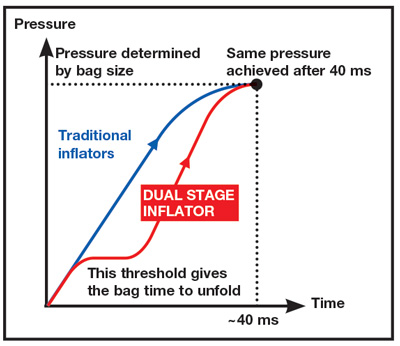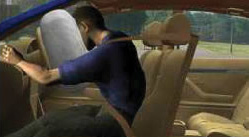|
||||
|
Your advanced frontal air bag is not intended to deploy in all crashes, even frontal crashes, especially when deployment may cause more harm than good or if the seat belts will provide enough protection on their own. The way an advanced frontal air bag deploys in a crash depends not only on the occupant factors mentioned above, but on several other key factors, such as:
|
 |
During moderate-to-severe frontal crashes, an advanced frontal air bag fully inflates in a fraction of a second to prevent you from hitting the interior of your vehicle. However, in lower speed frontal crashes where full force air bag deployment would be unnecessary or could cause injury to smaller occupants, an advanced frontal air bag system inflates at less than 100% to provide optimum protection. Deployment might be suppressed altogether. In the event of a rollover, side impact, or rear end crash, advanced frontal air bags are typically not designed to offer protection and may not even deploy.
Your Advanced Frontal Air Bag Needs a Partner - Your Seat Belt
Advanced frontal air bags are smart when it comes to sensing your weight, seat position and other factors but, again, they are intended to enhance—not replace—the protection of your seat belt! The same goes for front seat passengers. Seat belts are your first line of defense during a crash whereas air bags are a supplemental restraint system. Remember, it takes two: First your seat belt, then your air bag. Always buckle up before turning on the ignition, and make sure your front passenger is buckled up, too.
Key Safety Precautions
- Always wear your seat belt
- Adults: Keep a 10 inch minimum between your breastbone and the air bag cover - center of the steering wheel for drivers and on the dashboard for right front passengers.
- Place children 12 and younger in the back seat. Parents and caregivers should always place children 12 and under in the back seat in an appropriate child restraint system.
- Elderly and small stature adults should follow the same advice as other adults: Make sure you are properly belted, maintain a proper seating position and move the seat as far back as possible.
- Pregnant women should follow the same advice as other adults (see above), making sure the lap belt is positioned low on the abdomen below the fetus with the shoulder belt worn normally.
- Install new advanced frontal air bags after deployment. They cannot be reused.
- Check to see if your air bag readiness (warning) light is illuminated. If so, the air bag system might not perform properly in a crash. The vehicle should be serviced by a qualified technician without delay.
- Read your owner’s manual. No air bags, not even your advanced frontal air bags can be designed to handle every crash event.
